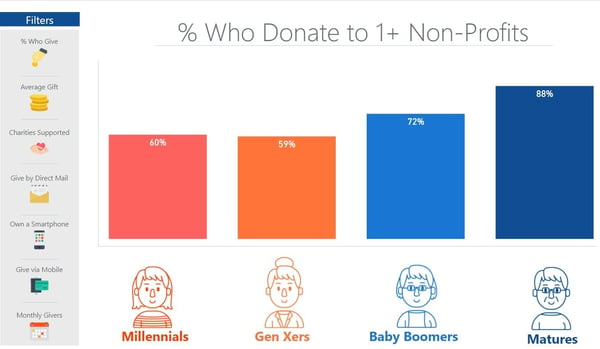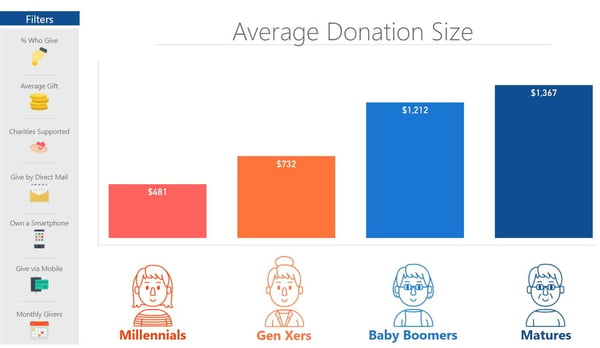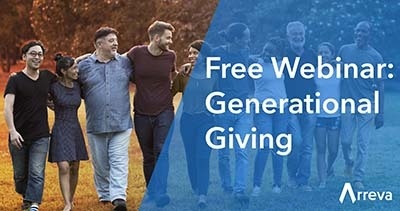Fundraising in a New Generational Landscape: Webinar Follow Up

As the primary source of major and recurring donations—Baby Boomers and Matures—begin to age and pass away, many nonprofits are beginning to try and acquire and cultivate younger generations as recurring donors within their organization
However, with so much information out about how different Millennials are from other generations, it can seem like you may have a difficult time getting Millennial donors and figuring out how to keep them around.
The good news is you don't need to overhaul your mission, you just have to rethink your messaging.
On Wednesday, May 30, we hosted a webinar that covered giving in a new generational landscape and offered some background on the differences between the generations, and offered some advice for communication strategies to Millennial and younger Gen X donors.
In addition to the webinar, we also had several great questions arise during the webinar that we did not have time to answer, so we're going to cover them here.
Watch the Webinar Here
1. What is alternative giving? Is that non-financial?
This was a great question that we sort of breezed past in the webinar, so I'll elaborate a little more here. The topics we referenced in the webinar were impact investing and social involvement. First, these types of giving are financial, but they aren't giving directly to any organization.
Impact Investing refers to financial investments made in companies, organizations, or funds that have the goal of making a measurable positive impact on social or environmental issues in addition to financial gain. An example of this would be someone investing in a company that's developing a more efficient type of solar panel or a company that manufactures and distributes water purifiers in countries where residents don't have access to clean drinking water.
Social involvement relates most frequently to a new business buzzword, "Corporate Social Responsibility." Social involvement is the act of choosing the for-profit businesses you support based on their support of a certain cause. The most notable of these types of companies are Tom's Shoes or the (RED) campaign. Here's a great Forbes article on 2018 CSR trends if you want to learn more.
Both forms of giving are examples of Millennials supporting a cause without directly supporting a specific nonprofit organization.
2. I'd be curious to hear more about organizations that are successfully using Snapchat for fundraising
I had a feeling we'd be answering some questions about Snapchat since it's kind of an "under the radar" social media platform for a lot of nonprofits, so I'm happy to give some references for where people can start learning about Snapchat for nonprofits and get some good examples.
One thing to point out is that currently, Snapchat doesn't have a way to collect donations within the app. At this point, it is a promotional tool for driving awareness and increasing engagement. But remember, as we stated in the webinar, it can take up to eight different points of engagement to convert someone to a donor, and this is a platform where you have a big opportunity to connect with younger generations. That said, here are some articles that cover Snapchat more in-depth:
- 4 Reasons Nonprofits Should Pay Attention to Snapchat
- How to (or not to) Use Snapchat for Your Nonprofit
- Five Nonprofits Who Are Ruling Snapchat
3. Would you please show the % Who Give and Average Gift slides again?
While we did go back to these in the webinar, I think it's worthwhile to post them again here since they're pretty helpful, so here you go:
 One thing that David pointed out in the webinar is that, while 88% of Matures and 60% of Millennials give, you have to remember the popular size of each generation.
One thing that David pointed out in the webinar is that, while 88% of Matures and 60% of Millennials give, you have to remember the popular size of each generation.
The current Matures population count is at 26.92 million; 88% of that is 23.69 million donors. The current population of Millennials is at 70.15 million; 60% of that is 42.09 million donors. That's 18.9 million more Millennial donors than Mature donors!

Now plug those numbers into the average gift size and you have Matures giving over $32 Billion and Millennials giving over $20 Billion. Millennials' average donation size is about a third of the amount, but it adds up to just under two-thirds of the total amount.
They may still be coming into their own, but Millennials will one day replace Boomers and Matures as top donors, but to collect their future donations, you need to begin engaging with them today.


